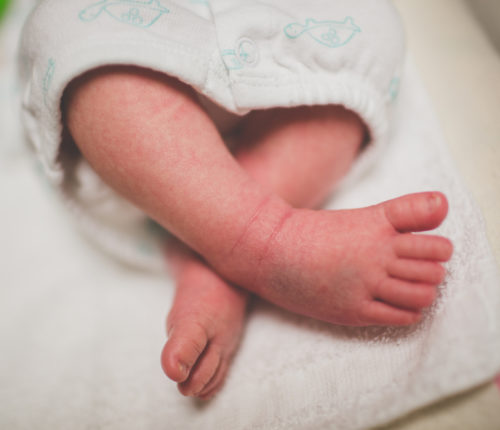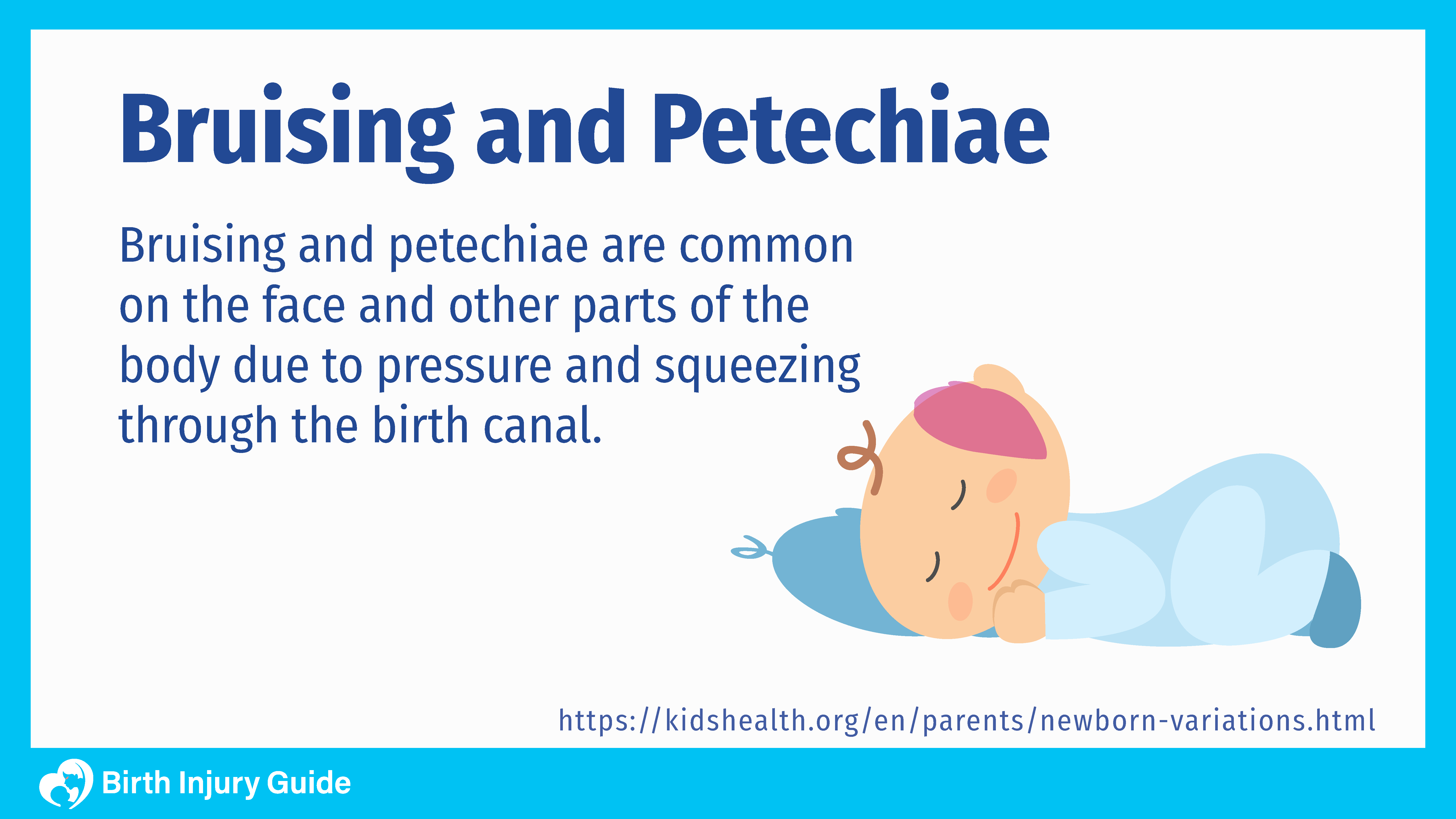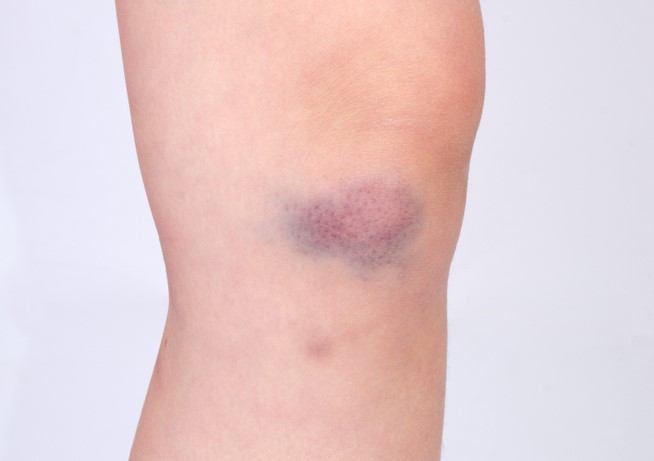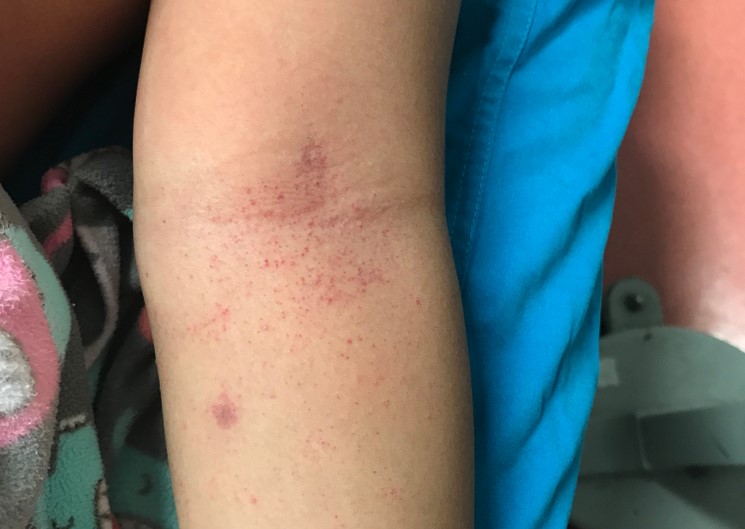
Bruising and Petechiae
Although birth trauma is relatively rare in the United States, it is estimated that 6 to 8 out of every 1,000 live births result in some type of injury, including bruises and petechiae. Many of these injuries occur as a result of the baby’s passage through the birth canal during delivery. In most cases, bruises and petechiae heal on their own.

However, some bruises may be signs of birth trauma caused by problems with the mother’s health or medical errors made by doctors or other medical personnel.
What is Bruising and Petechiae?

Bruising occurs when capillaries break and blood cells seep out deep under the skin and blood collects near the surface of the skin. The result is the trademark “black and blue” marks on the skin. Over time as the body breaks down the substances in the blood cells, bruises change color and may appear purple, brown or even green.

Petechiae is also caused by bleeding under the skin, but instead of a bruised appearance, the marks look more like a rash made of dots. Petechiae is the result of tiny blood vessels breaking open. Blood then leaks into the skin, which is why it appears more like a rash.
Generally, bruising and petechiae are not something to be concerned about on their own. However, if your child has suffered a birth injury or has other symptoms, there may be an underlying cause that is more serious than a bump or minor injury. It is always best to talk to your doctor if your child suddenly develops bruising or petechiae.
Types of Birth Injuries Linked to Bruising and Petechiae
There are a variety of conditions and birth injuries that can lead to bruising and petechiae. Some are minor and may not require any treatment at all. Others, however, may be more extensive and may require medical intervention. Some of the birth injuries that may include bruising and petechiae include:
Birth Trauma
Although some incidents that lead to infant bruising are inevitable, some are the result of medical errors and poor judgment. Improper use of vacuum extractors or forceps may result in painful contusions or other injuries. When a doctor uses too much force with birth assisting tools, the infant can suffer from bruising, petechiae, cuts, lacerations, or more serious injuries.
Subconjunctival Hemorrhage
While not technically a “bruise”, a subconjunctival hemorrhage occurs when the tiny blood vessels under the surface of the eye rupture. This is often caused by birth trauma. Parents often notice their baby has redness around the eyes, or has a bright red spot on the white of the eye.
Contusions (Bruises)
Childbirth is a traumatic experience for a baby’s body even under the best of circumstances. The mother’s pelvic bones and the muscles of the birth canal exert pressure on a newborn during labor. This causes some breakage in the baby’s capillaries and venules and forms contusions or bruises.
There are three types of contusions: subcutaneous, intramuscular and periosteal.
- Subcutaneous contusions occur under the skin.
- Intramuscular contusions occur within muscle tissue.
- Periosteal contusions occur under or on top of the bones.
Contusions can also be caused by the use of medical instruments, especially forceps. The pressure of the forceps’ branches upon a baby’s head or face can cause bruising. Also known as forceps marks, these bruises eventually heal on their own.
Vacuum extraction may also cause bruising to the baby’s scalp. In some cases, however, the use of the vacuum extraction, or ventouse method can cause cuts known as lacerations. Normally, lacerations are superficial and require minimal medical treatment. However, deep lacerations may require stitches and other types of medical intervention to prevent complications. Lacerations from vacuum extractions are very rare.
Caput Succedaneum
Caput succedaneum is a medical condition marked by swelling on an infant’s scalp’s soft tissues. It is often a result of a difficult labor, especially after the uterine membranes break and as the baby’s head descends into the birth canal. Caput succedaneum is caused by pressure of the uterus, vaginal wall and muscles on the baby’s head. Bruising occurs when there are swelling and remodeling of the soft, delicate tissues of the baby’s scalp.
The principal sign of caput succedaneum is a soft, puffy swelling of the scalp, particularly on the part of the head that emerged first. In many cases, the condition is accompanied by bruising. Though bruises may occur naturally as a result of the baby’s passage through the birth canal, it is more likely to be caused by the use of vacuum extractors.
Cephalohematoma
Cephalohematoma, sometimes called a baby hematoma, is an accumulation of blood underneath the skin and dense membrane of the skull but not underneath the skull. It occurs between the periosteum-the outermost portion of the skull bone and the dense membrane. It is usually noticeable several hours after birth and appears as a lump on the top of the baby’s head. These lumps only form on one side of the skull, usually at the point of most contact between the baby’s head and the mother’s pelvic bones.
Cephalohematomas vary in size. Small ones may disappear within two weeks, while larger collections of blood may be visible for as long as three months. They clear up completely when the baby’s body reabsorbs the blood. If the area affected is large, the breakdown of red blood cells may cause jaundice in some babies.
Neonatal Sepsis
Neonatal sepsis can develop when the mother and/or infant have an infection. Sepsis is the body’s overwhelming response to an infection. Petechiae is one of the common symptoms of sepsis, along with fever, difficulty breathing and a fast heart rate.
Risk Factors for Bruising and Petechiae
Although most infant bruising is merely a side effect of the physical stresses of labor and birth, it can also be a sign of injuries sustained during delivery. These injuries can be traced to several risk factors, including difficult births. Long and arduous labors are often the result of:
- Large babies that weigh over 8 pounds, 13 ounces
- Premature babies born before 37 weeks
- Cephalopelvic disproportion, which occurs when the infant’s head is too large to fit through the mother’s pelvis
- Breech births
In difficult births, there is an increased risk that some type of birth trauma may occur. All babies can receive birth injuries as a result of prolonged labor. However, premature babies run a greater risk of being injured at birth because they are smaller and have more delicate bodies.
Difficult births require doctors to pay close attention to both the mother and baby to make sure the delivery goes as well as possible. At the same time, physicians and other medical staff have to intervene quickly to help the baby out of the birth canal, especially if either the mother or infant are in distress.
In these situations, attending doctors may use instruments like forceps or vacuum extraction to extract the baby. Though these medical tools are useful and solve many birth-related complications, they can also cause birth injuries, including infant bruising and petechiae.
Treatment for Bruising and Petechiae
The treatment that your child receives for bruising and petechiae will depend on the underlying cause. For example, if a minor viral infection is the cause of bruising and petechiae, the bruising should clear up once the infection is healed. Your child’s doctor will be able to tell you what sort of treatment, if any, is necessary for your child’s bruising or petechiae. Depending on the cause, some possible treatment options include:
- Antibiotics to resolve an infection
- Corticosteroids to relieve inflammation
- Immune-suppressant medications
There are also things you can do at home to help relieve discomfort associated with bruising or petechiae. These remedies include:
- Encourage your child to rest
- Have your child take over-the-counter pain medication like Tylenol or ibuprofen
- Have your child drink lots of fluids to keep him or her from becoming dehydrated
Start Your FREE Case Review Today
If you or your child is injured as a result of medical negligence, call us to learn more.



